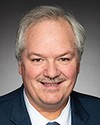Agreed.
Evidence of meeting #60 for Health in the 44th Parliament, 1st Session. (The original version is on Parliament’s site, as are the minutes.) The winning word was amendment.
A recording is available from Parliament.
Evidence of meeting #60 for Health in the 44th Parliament, 1st Session. (The original version is on Parliament’s site, as are the minutes.) The winning word was amendment.
A recording is available from Parliament.
12:15 p.m.
Some hon. members
Agreed.
12:15 p.m.
Liberal

The Chair Liberal Sean Casey
(Subamendment withdrawn)
Thank you very much, Mrs. Goodridge.
We're now back to debate on the amendment, which is G-2. I recognize Monsieur Thériault.
12:15 p.m.
Bloc

Luc Thériault Bloc Montcalm, QC
Thank you, Mr. Chair.
I would like to go back to my last statement, to clarify the first use of the word “prescribed” in the amendment. The amendment refers to prescribed foods and prescribed levels.
Why is the first “prescribed” used? In the simplest, most concise way possible, explain to me what it would mean if we removed it.
12:15 p.m.
Chief Regulatory Officer, Health Products and Food Branch, Department of Health
The use of the term “prescribed” is the grant of authority to make a regulation about which foods the prohibition would apply to. It indicates that the minister, through the Governor in Council, can specify foods through regulations that will be subject to this prohibition.
12:15 p.m.
Bloc

Luc Thériault Bloc Montcalm, QC
If foods are covered by the regulation, they are certainly prescribed. Why would this need to be specified in the act? Is it because the second “prescribed” is not sufficient?
It says “advertising of prescribed foods that contain more than the prescribed levels of sugars, saturated fat or sodium in a manner [...]”. However, saying “prohibit the advertising of foods that contain more than the prescribed levels of sugars, fats” would be completely correct, right?
Isn't it enough to say it like that and just take out the first “prescribed”? What am I not understanding? Can someone explain this to me in a different way?
12:15 p.m.
Chief Regulatory Officer, Health Products and Food Branch, Department of Health
Again, in the act, “prescribed”, when you use it in this kind of context, means “prescribed by regulation”. You would read that whole phrase just before “foods” as “food prescribed by regulation”. It's a convention. It's also in the act, in section 2. It means “prescribed by the regulations”. It just leaves it for the regulations to define.
I will turn to Dr. Sharma regarding how we would do that, but that's certainly the convention.
12:15 p.m.
Chief Medical Adviser and Senior Medical Adviser, Health Products and Food Branch, Department of Health
Perhaps I will add this: If we left the word as just “foods”, that “no person shall advertise foods”. Then, the question is, “Which foods?” The way it's worded in the original clause, there's some vagueness to it. We don't know what “contribute” means. “Excess” would have a whole definition as well. “Excess”, depending on the way you look at it, can be an amount or a percentage. It changes for different groups. How do we say which foods would be included?
The way we would usually do that is that we would have something to point to—a regulation—to help define which foods those were.
12:20 p.m.
Bloc

Luc Thériault Bloc Montcalm, QC
I understood the difference between the amendment and the original wording. As for the words “contribute to an excess”, I do understand that prescribed levels will be defined in the amendment and that is important. My question was simply this. Why use “prescribed foods” and why use the term "prescribed" twice?
I am told that this is a convention, that this is what we call foods that are going to exceed the permitted levels.
However, nothing is known at this time about either the levels or the foods that make up the list.
Will there be such a list? Will the levels ultimately define what will be listed as proscribed?
12:20 p.m.
Chief Medical Adviser and Senior Medical Adviser, Health Products and Food Branch, Department of Health
I don't know if this answers your question, but it gives us an opportunity to define a type of food and a level. So the word “prescribed” is used once to define a food category, and a second time to qualify the levels of fat, salt, or any other component of the food.
12:20 p.m.
Bloc

Luc Thériault Bloc Montcalm, QC
The term “prescribed” is therefore used to define the category of foods to which we will assign prescribed or non-prescribed levels. Is that how it should be understood?
12:20 p.m.
Chief Medical Adviser and Senior Medical Adviser, Health Products and Food Branch, Department of Health
Yes, that's right.
12:20 p.m.
Liberal

The Chair Liberal Sean Casey
Mr. Davies, you had your hand up when we were discussing the subamendment. Do you still wish to intervene?
12:20 p.m.
NDP

Don Davies NDP Vancouver Kingsway, BC
I did, but when the subamendment was withdrawn, I no longer did at that point.
I do have a follow-up question to Mr. Thériault's questions, just to make sure I understand.
The reason I think we have the double prescription is that there are, really, two tests to be met for an advertiser to be prohibited from advertising to children under 13. It has to be food that's listed that also contains more than the prescribed level of sugars. The reason I understood this was necessary, after our last meeting, is that, if you didn't have the first “prescribed”—if you just had “foods that contain more than the prescribed level of sugars”—that may capture things we don't want to capture, because they may have more than the prescribed sugars. I'm sorry about my bad science, but it could be like an orange or an apple. It may have higher than the prescribed levels of sugar, but it's not something we want to prohibit in advertising. I think the reverse is true as well. It wouldn't just be....
I guess you could just have “prescribed foods”. If you did the homework in advance and only put “prescribed foods that meet the prescribed levels of sugars, saturated fat or sodium”, which were predetermined, you would not necessarily need the second “prescribed”. That's kind of where.... I understand the first “prescribed”, but why is the second one necessary? Could you not do that work in advance and simply put, on the prescribed list of foods that can't be advertised, prescribed foods that don't meet the level of sugar, saturated fat or sodium? Why do we need that second part?
12:20 p.m.
Chief Regulatory Officer, Health Products and Food Branch, Department of Health
It's for interpretability, and to have very clear authority to set levels as well. We'll have categories for, perhaps, “prepackaged”. That's a category you see a lot in the regulations. Then, for the levels, we would need regulatory authority to set those. Hypothetically, if it was just for prescribed foods, you could try to build that in, but it's to have the grant of both, because both parameters are going to be very important. Companies will need to know when they are at that level and have it very clearly specified.
For enforceability and clarity, it's good to have both the food and the level.
12:20 p.m.
Liberal

The Chair Liberal Sean Casey
Is there any further discussion on amendment G-2?
(Amendment agreed to [See Minutes of Proceedings])
That brings us to CPC-1.
We need someone to move CPC-1.
Thank you, Ms. Goodridge.
12:25 p.m.
Conservative
12:25 p.m.
Conservative

Laila Goodridge Conservative Fort McMurray—Cold Lake, AB
Thank you, Mr. Chair.
I will speak very briefly to this amendment. This is as a result of feedback we heard from a variety of stakeholders with concerns that things like Timbits soccer or Timbits hockey wouldn't be able to continue, or that youth wouldn't be able to play in a hockey arena that had a scoreboard sponsored by Pepsi or Coca-Cola. We just wanted to have that exclusion.
Perhaps we could hear from our witnesses whether this would actually achieve that goal and if there were any possible problems in it.
12:25 p.m.
Liberal

The Chair Liberal Sean Casey
Just before we get there, Ms. Goodridge, now that the amendment has been moved, I have to rule on its admissibility. That may dispense with the need for a response to your question.
Bill C-252 amends the Food and Drugs Act to prohibit food and beverage marketing to persons under 13 years of age. CPC-1 seeks to promote a healthy lifestyle in children through sports and athletic programs, which is not contemplated in the bill. As House of Commons Procedure and Practice, third edition, states on page 770, “An amendment to a bill that was referred to a committee after second reading is out of order if it is beyond the scope and principle of the bill.”
In the opinion of the chair, the amendment introduces a new concept to the bill that goes beyond the scope of the bill. Therefore, I rule the amendment inadmissible.
Given that CPC-1 is inadmissible, it brings us now to CPC-2.
Mr. Jeneroux.
12:25 p.m.
Conservative

Matt Jeneroux Conservative Edmonton Riverbend, AB
I don't want it to be as dramatic as challenging the chair—
12:25 p.m.
Voices
Oh, oh!
12:25 p.m.
Conservative

Matt Jeneroux Conservative Edmonton Riverbend, AB
I guess I'm softly challenging the chair, if that's a thing.
If you don't mind, Mr. Chair, maybe you could read your ruling again. I guess I'm a little confused as to whether or not it's because of the advertising-specific piece that it's outside of the Food and Drugs Act, or if it's the reference to kids. It kind of seems as though we talked about some of this stuff. Part of Ms. Lattanzio's presentation was on that.
Maybe if you read it again it might click. A soft ruling back would be helpful, but....
Thank you.
12:25 p.m.
Liberal

The Chair Liberal Sean Casey
Bill C-252 amends the Food and Drugs Act to prohibit food and beverage marketing to persons under 13 years of age. Amendment CPC-1 seeks to promote a healthy lifestyle in children through sports and athletic programs, which is not contemplated in the bill. As House of Commons Procedure and Practice, third edition, states on page 770, “An amendment to a bill that was referred to a committee after second reading is out of order if it is beyond the scope and principle of the bill.”
In the opinion of the chair, the amendment introduces a new concept to the bill that goes beyond the scope of the bill. That's why I ruled the amendment inadmissible.